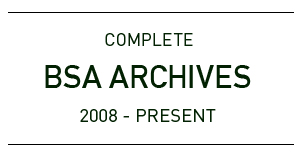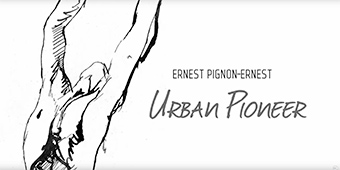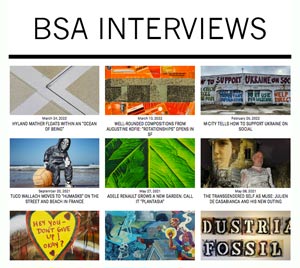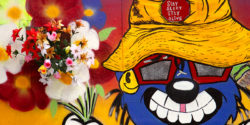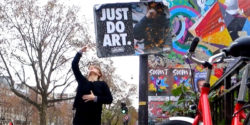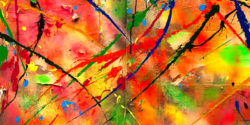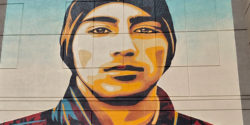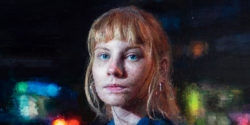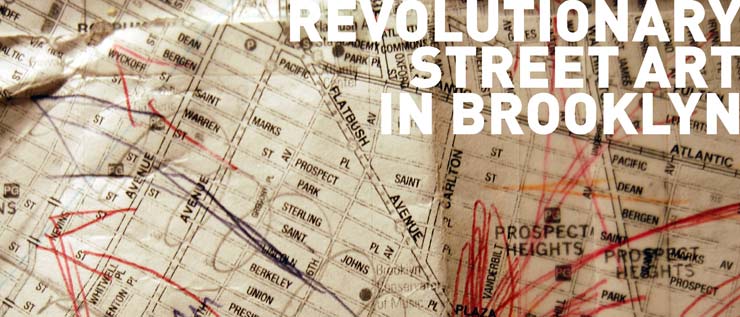
If you pay close attention, you will always see something new on the street in Brooklyn. Thanks to the imagination and efforts of General Howe, a street artist who has been laboring carefully in small scale plastic soldiers placed in historically accurate locations on the street, you may also get an education. In this most unusual of street artists lies a deep commitment to honoring the sacrifices of soldiers of war and he deploys his installations to help us learn some of the history that our culture has forgotten – and hopefully draw some connections to the current wars we are engaged in.
From General Howe:
“I make war in Brooklyn. Did you know the Revolutionary War was fought in Brooklyn? Did you know we’re at war in Afghanistan and Iraq? It’s easy to forget we’re battling in foreign lands against invisible adversaries. I bet you know more about Call of Duty: Modern Warfare 2. This is why I make war in Brooklyn.”
General Howe (Photo © Jaime Rojo)
Brooklyn Street Art: How did you get so interested in history?
General Howe: I used to work in the United States Senate and was exposed to U.S. government, politics, and history all day, every day. If I found something interesting I would explore it further in the senate library. After reading the book 1776 by David McCullough I realized that a portion of the Revolutionary War (now known as the Battle of Brooklyn) went down in the neighborhoods I lived and travel in within Brooklyn. I’ve been researching locations and events of the Battle of Brooklyn for about three years now. For example, the area of the Brooklyn Navy Yard was a bay filled with British prison ships. Over ten thousand patriot soldiers died in those ships due to poor conditions or torture. Places where we live, work, eat, and socialize are the same places where people fought, killed, and died during a revolution. Coincidentally, I find a lot of street artists working in these same locations.
BSA: In your art you work with plastic toy soldiers in installations and collage, do you go back to memories of your childhood playing with toy soldiers?
General Howe: Childhood experiences have become a big part of my process. If you watch a 5-year-old play, they have so much magic and imagination going through them that is hard to match as an adult. The battles I make are influenced by all the pretend battles I fought growing up. Reflecting on the countless hours I would spend with my friends or by myself hunting down bad guys with plastic guns or spears made of tree branches was so intensely creative. I try to tap into that same energy. To help me do this, I have been collecting old coloring books, games, and toys that I had growing up.
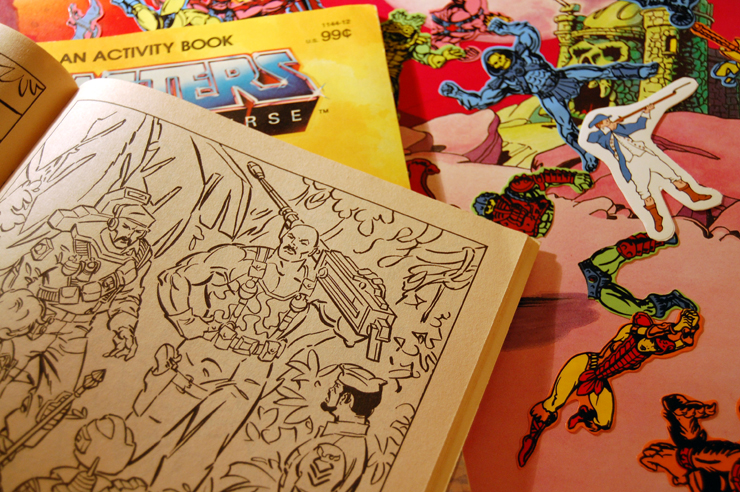
A look around his fort reveals influences for General Howe.
BSA: The Battle of Brooklyn plays a big role in your installations. What significance is this battle to you and to the country?
General Howe: The significance of The Battle of Brooklyn is that I feel more connected to it and its purpose then the current wars we’re fighting in the Middle East. It’s definitely significant to our history as a country. We almost lost the entire revolution in Brooklyn. Washington recognized that the British had the upper hand at the time, so he had the entire army retreat to Manhattan. It took many losing battles and retreats, but eventually we gained the upper hand and the rest is history.
General Howe (Photo © Jaime Rojo)
BSA: Is there a central message that you want to convey with your work and installations?
General Howe: There isn’t really a central message, more like a central goal. The goal of my work is for the viewer, or participant, to have an experience of reflection on his or her own experiences. Be it, war, childhood, or anything else that comes to the surface. We were attacked on 9-11 and we’ve been fighting 2 wars in the Middle East. It seems like that is all easily forgotten in our daily life. As we get older our childhood diminishes and memories are forgotten. For myself, I need to hold onto those memories in order to understand what’s going on now and live through it.
BSA: The American assemblage artist Joseph Cornell spent a lot of his life in Queens. Do you see his work as an important influence on yours?
General Howe: The quality a self-taught artist produces is intriguing to me, but Joseph Cornell has not had an influence on my work. The work for shows, and recent street ICON pieces I have been making, are influenced by religious icons. One summer I spent some time studying art in Venice, Italy and I would sometimes stumble across religious icons built into actual walls of buildings in random streets and alleyways. Their purpose is to invoke spirituality and reflection. I try to achieve this same experience in the context of being in the street environment, childhood play, and of actual war.
The writings of John Dewey have had a major influence on my work and me personally. Walking around Brooklyn looking at the different textures and decay along with various forms of street art and graffiti provides constant inspiration.
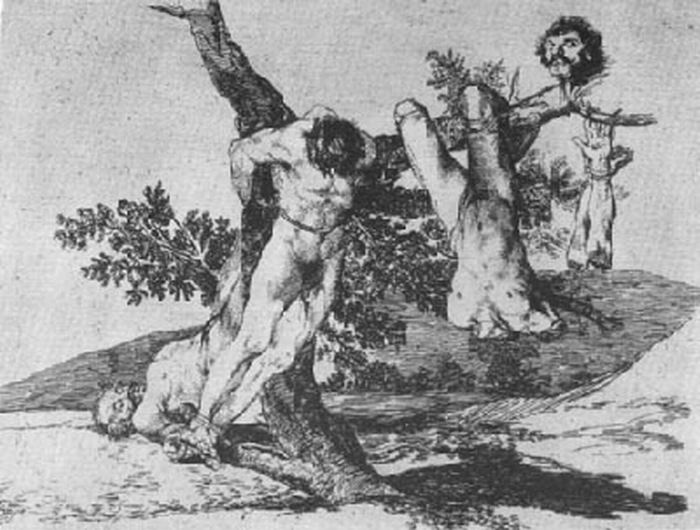
- A rendering by Goya for his “Disasters of War”
Influential Artists for General Howe:
Seeing SWOON’S (and many partners) boats from Swimming Cities of Switchback Sea float down the East River will be a memory I never forget. The wheat pastes of Elbow-Toe never get old. Thundercut crosswalk stickers are brilliant and I always look forward to new Peru Ana Ana Peru films. The prints of Goya, especially Disasters of War are timeless and three of my favorite paintings are Thérèse Dreaming by Balthus, The Guitar Player by Manet, and The Death of Marat by David.
I am also an art teacher at a rigorous high school and the drive and dedication my students posses definitely keeps me going.
General Howe (Photo © Jaime Rojo)
BSA: When you are manipulating and carefully placing your figures, do you worry that they will be stepped on?
General Howe: No way, part of the reason I became interested in street art was the ephemeral quality the work attains once placed in the street. The environment, nature, or people will unpredictably change the work. In one installation someone melted all the soldiers down to figurative stumps. Another person tastefully rearranged a battle inside a hollowed out log. Whether they’re playing with or destroying a battle, the fact that they’re spending time to do that and having an experience is why I create work in the street.
General Howe (Photo © Jaime Rojo)
BSA: Can you hear a dialogue among the figures in your head when you are working with them?
General Howe:
Poncho: You’re bleeding, man. You’re hit.
Blain: I ain’t got time to bleed.
(From the movie Predator)
Other Articles You May Like from BSA:
Street Art A-Lister Mr. Anthony Lister is up and around the hood this past week or so with some fresh aerosol and automatic madness. The Brooklyn-Brisbane based contemporary artist is also opening at ...
Welcome to BSA Images of the Week! 21 years since the Twin Towers came down here in New York City. We remember today in our hearts. Reliably, street art plays a role in bringing up the soc...
Our weekly focus on the moving image and art in the streets. And other oddities. Now screening : 1. Fin DAC and 'Shukumei' on a Rooftop in San Francisco 2. Nevercrew in Satka 3. Dabs & Myla ...
Experience the synergy of history and contemporary creativity during this summer's Nice Surprise street art festival with BSA in this Norwegian city. Join us as we celebrate Stavanger's 900-year ...
If you are wondering why you are seeing a lot more lumpen and average people than usual on the streets of NYC recently it may be attributable to the wheat-pasted everymen and everywomen from the Chic...
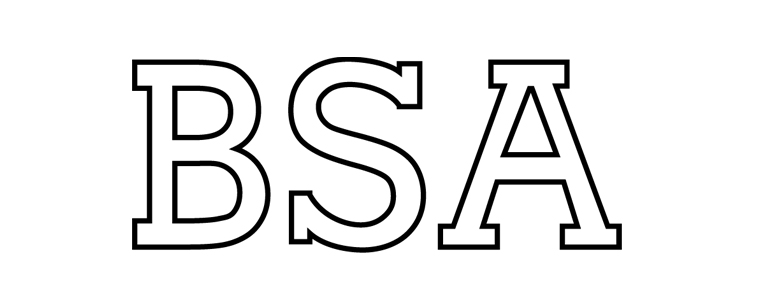 BROOKLYN STREET ART LOVES YOU MORE EVERY DAY
BROOKLYN STREET ART LOVES YOU MORE EVERY DAY